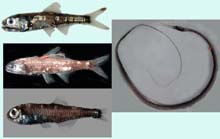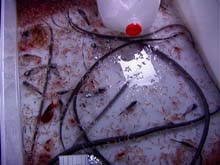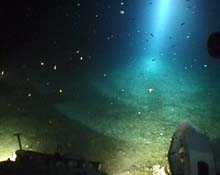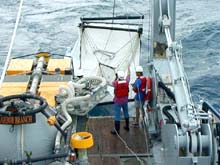A Brief view of Open Ocean Midwater Ecology
Dr. Steve W. Ross
North Carolina National Estuarine Research Reserve, Wilmington, NC
Dr. John V. (Jack) Gartner, Jr.
St. Petersburg College, St. Petersburg, FL
Dr. Ken J. Sula
USGS, National Biological Survey, Gainesville, FL
In addition to the work we conduct with the habitats and animals on the ocean bottom, we also collect data in the less well-known “mid-water” or mesopelagic realm. This region forms the link between the ocean surface and the bottom. In fact, these midwater depths, ranging from 200 meters (660 ft) to the very bottom of the ocean trenches (more than 11,000 m or almost 7 mi) are the largest ecosystems on Earth. It has been estimated that a species of fish (genus Cyclothone - small flabby fishes with tiny eyes, large mouths and bead-like luminescent organs along their flanks) inhabiting this vast area outnumbers any other vertebrate animal. One reason we are studying this environment is to determine to what extent it is a route for energy exchange between the ocean’s surface and the depths, and to discover whether energy flow occurs in both upward and downward directions.

Four typical midwater fishes (3 different lanternfishes on left, snipe eel on right) from our collections. Click image for larger view.
This vast living space is typically divided into three vertical zones by deep-sea biologists. The mesopelagic zone (Meso – middle; pelagic – living in open water) is the shallowest, ranging from about 200 to 1,000 m depth. Over this depth range, natural sunlight dwindles to extinction. It is within this depth range that the Johnson-Sea-Link submersible can traverse. To our eyes, the outside waters appear totally dark by about 450-550 m, but to the inhabitants, whose special adaptations include extremely light-sensitive eyes, sunlight can be perceived to about 1,000 m in the clearest ocean waters. The bathypelagic (Bathy = deep) encompasses depths below the mesopelagic to about 4,000 m, or the upper edges of most ocean trenches. The waters here are uniformly cold, with extreme pressure and no natural sunlight. The only light found here is produced by bioluminescence from the living inhabitants. Very few submersibles are capable of descending into this zone, so most of what we know of this realm comes from net collections. The third zone, the hadopelagic (hado – from Hades, the mythological underworld), encompasses the waters within ocean trenches, and has been very poorly studied to date.
The midwater component of our research, both during recent cruises and in previous years, has focused on the mesopelagic zone. These are the depths that we can simultaneously sample by trawl and view using the submersible. We believe that the inhabitants of this zone play a critical role in the movement of energy from the rich, shallow ocean waters above 200 m to the ocean floor, especially along the continental slopes.

An unsorted Tucker trawl catch showing snipe eels, krill shrimps, and lanternfishes. Click image for larger view.
A number of different trawl designs are used to collect midwater animals. We use a fairly simple design called an “opening-closing Tucker trawl.” This net can be sent down to a specific depth, closed, and then returned to the surface. Around-the-clock sampling allows us to develop a good picture of where different organisms live during the day and night. Through the use of these nets and other sampling apparatus, scientists have discovered that many species of midwater animals, including fishes, shrimps and gelatinous organisms (e.g. jellyfishes and comb jellies), perform what we call “diel vertical migrations." This means that they typically reside in the lower mesopelagic zone (500-850 m) during the day, but swim upwards to very shallow depths (<100 m to the surface) at night. Most do this every day and night. Since most of these animals are quite small (60 millimeters or less), distance-wise, this is the equivalent of a 6-ft-tall person running about 25 mi twice a night and completing each run in about 2 hrs.
One of the most abundant fish groups that we collect in the waters over the continental slopes is the family Myctophidae (Lanternfishes), and they are among the most diverse of all oceanic fish families. In appearance, they are similar to anchovies, with large heads, mouths, and eyes. As their name implies, they also bear numerous luminescent organs, the intensity of which comes under the nervous control of the fish. We have observed and collected lanternfishes, as well as other midwater animals (squids, krill, hatchetfishes, snipe eels), from the waters overlying some of the deep-reef regions. However, many of the more inshore reefs studied in this program are too shallow for mesopelagic animals.

View from the submersible of lanternfishes and hatchetfishes swarming near the bottom of a deep coral bank off Cape Lookout, NC. Click image for larger view.
Our trawl collections in the region of the western Atlantic known as “The Point” (off Cape Hatteras) are unusual in several respects. First, we do not get the diversity of species we would normally expect from this region. In fact, only a few species account for almost all individuals collected. Second, one species of lanternfish is highly dominant in western Atlantic slope waters, but is almost completely absent from our catches.
The use of the Johnson-Sea-Link to observe the open waters on the way to the bottom and back to the surface has helped us to explain the second riddle. We found that the "missing" species is often located in vast swarms in close proximity to the bottom, usually within ten m. When the submersible enters these swarms, it is reminiscent of the photographs showing divers surrounded by huge schools of silvery herring or sardines. Around and within these large swarms are numerous other mesopelagic animals, including shrimp, eels, and several species of silver or brass-colored predatory fishes called “barracudinas." All of these are encountered in much greater numbers and in very different locations than we expected, a testimony to the powerful observation platform provided by the submersible. We have also observed such bottom swarms of typically midwater animals at other locations. Their presence and behavior in these benthic locations, and the resulting ecological implications, form the current focus of our research.
Sign up for the Ocean Explorer E-mail Update List.















































